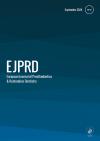European Journal of Prosthodontics and Restorative Dentistry
Comparative Evaluation of Microtensile Dentin Bond Strength and Interfacial Micromorphology of Three Universal Adhesives
Abstract
Objectives: To assess and compare the microtensile dentin bond strength (µTBS) and interfacial micromorphology of three universal adhesives. Methods: 96 human molars were assigned to three universal adhesives: Single Bond Universal (SBU), CLEARFIL Universal Bond Quick (UBQ), and RE-GEN Universal Adhesive (REGEN). Adhesives were applied in self-etch mode. SBU and REGEN were applied following the manufacturers’ instructions. UBQ was divided into two subgroups: one following the manufacturer’s instructions (UBQ Short) and the other with an extended application time (UBQ Extended). Teeth were
restored with nanohybrid resin composite. Specimens were divided into immediate and delayed subgroups. The delayed subgroups were stored for 6 months and subjected to 5000 thermocycles. µTBS was tested, and failure mode was analyzed. Interfacial micromorphology was assessed using a scanning electron microscope. The data were statistically analyzed (p < 0.05). Results: The adhesive choice, aging, and their interaction significantly affected µTBS. SBU exhibited the highest immediate µTBS, comparable to UBQ (Extended) and REGEN, and significantly higher than UBQ (Short). In delayed testing, SBU outperformed the other adhesives. Conclusions: Aging negatively affected the µTBS of UBQ and REGEN, while SBU wasn’t affected. The quick application concept of UBQ deteriorated its µTBS compared to the extended application time.
Keywords
Universal Adhesives
Microtensile Bond Strength
Micromorphological Analysis
Authors
Yassmine Fathy, Naglaa R. ElKholany, Asmaa M. AbdAllah, Nadia M. Zaghloul
Articles from this issue
 Free Access
Free Access No Access
No Access Full Access
Full Access


